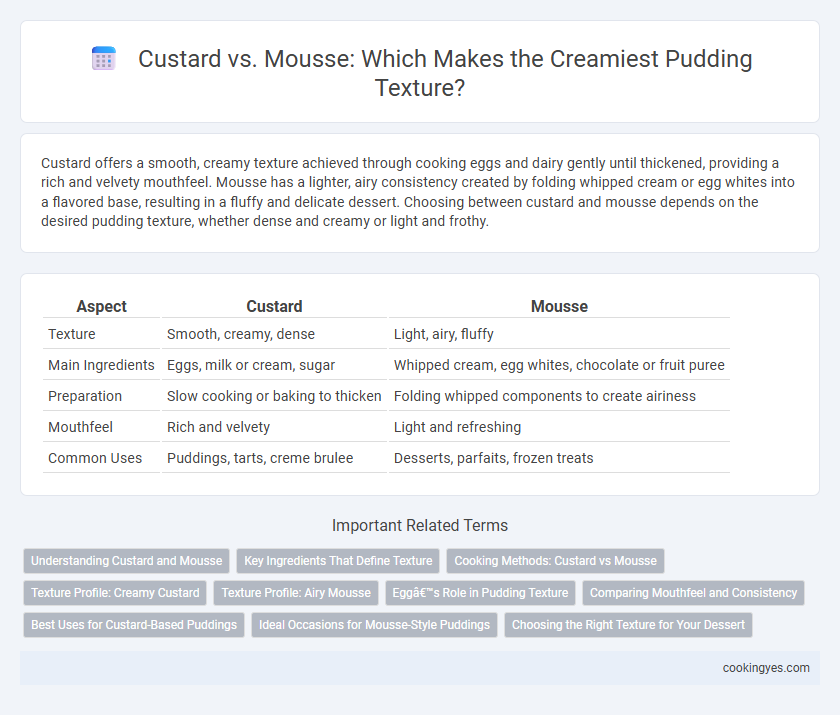Custard offers a smooth, creamy texture achieved through cooking eggs and dairy gently until thickened, providing a rich and velvety mouthfeel. Mousse has a lighter, airy consistency created by folding whipped cream or egg whites into a flavored base, resulting in a fluffy and delicate dessert. Choosing between custard and mousse depends on the desired pudding texture, whether dense and creamy or light and frothy.
Table of Comparison
| Aspect | Custard | Mousse |
|---|---|---|
| Texture | Smooth, creamy, dense | Light, airy, fluffy |
| Main Ingredients | Eggs, milk or cream, sugar | Whipped cream, egg whites, chocolate or fruit puree |
| Preparation | Slow cooking or baking to thicken | Folding whipped components to create airiness |
| Mouthfeel | Rich and velvety | Light and refreshing |
| Common Uses | Puddings, tarts, creme brulee | Desserts, parfaits, frozen treats |
Understanding Custard and Mousse
Custard features a smooth, creamy texture achieved by gently cooking a mixture of eggs, milk, and sugar until it thickens, creating a rich and velvety pudding base. Mousse incorporates whipped cream or egg whites folded into a flavored base, resulting in a light, airy consistency with a delicate, melt-in-the-mouth feel. Understanding these distinct preparation methods highlights the fundamental difference between custard's dense creaminess and mousse's fluffy, cloud-like texture.
Key Ingredients That Define Texture
Custard's smooth, creamy texture is primarily defined by the use of egg yolks and milk or cream, which coagulate during gentle heating, creating a rich and velvety consistency. Mousse achieves its airy, light texture through the incorporation of whipped egg whites or whipped cream, which introduce air bubbles that provide a fluffy mouthfeel. The balance and treatment of these key ingredients--proteins in custard and aeration in mousse--are essential in differentiating their unique pudding textures.
Cooking Methods: Custard vs Mousse
Custard achieves its creamy, smooth texture through gentle cooking techniques like stovetop simmering or water bath baking, which allow egg proteins to thicken the mixture gradually without curdling. Mousse relies on folding air into whipped cream or egg whites, often without heat, to create a light, airy consistency that contrasts with custard's dense richness. The cooking method is crucial in determining custard's firm but silky texture versus mousse's delicate, fluffy structure.
Texture Profile: Creamy Custard
Creamy custard pudding features a smooth, velvety texture that melts gently on the palate, achieved through a careful balance of eggs, milk, and sugar cooked to a silky consistency. Unlike mousse, which incorporates whipped cream or egg whites for a light, airy structure, custard offers a dense, luscious mouthfeel with a rich, uniform creaminess. This distinct texture profile makes custard ideal for classic pudding recipes requiring a thick yet tender base.
Texture Profile: Airy Mousse
Custard features a smooth, creamy texture achieved through gentle cooking and thickening with eggs, creating a dense yet silky pudding base. Mousse stands out with its airy, light texture, incorporating whipped cream or egg whites to introduce a fluffy, melt-in-the-mouth sensation. This airiness gives mousse a delicate structure that contrasts with custard's richer, more substantial mouthfeel.
Egg’s Role in Pudding Texture
Eggs provide structure and richness in custard pudding by coagulating when heated, creating a firm yet creamy texture. In mousse, eggs often appear whipped or as yolk and white components, incorporating air that delivers a light, airy consistency. The distinct egg treatment directly influences custard's smooth density versus mousse's delicate fluffiness.
Comparing Mouthfeel and Consistency
Custard offers a smooth, creamy texture with a velvety mouthfeel that feels thick and rich on the palate, thanks to its egg-thickened consistency. Mousse features a light, airy texture created by whipped cream or egg whites, resulting in a fluffy, delicate mouthfeel that melts quickly. While custard provides a dense, uniform consistency ideal for a satisfying, heavy pudding, mousse delivers a soft, porous structure that feels lighter and more ethereal.
Best Uses for Custard-Based Puddings
Custard-based puddings offer a rich, creamy texture ideal for desserts like flan, creme brulee, and bread pudding that require a smooth and velvety consistency. Their dense yet tender structure holds up well to baking and chilling, making them perfect for layered desserts or as fillings in pastries and tarts. Custard's stability under heat also enhances its suitability for recipes needing slow cooking or gentle setting without compromising its luxurious mouthfeel.
Ideal Occasions for Mousse-Style Puddings
Mousse-style puddings, characterized by their airy, light texture achieved through whipped cream or egg whites, are ideal for festive celebrations and elegant dinner parties where a delicate dessert is preferred. Their smooth, fluffy consistency pairs well with fruit garnishes and sparkling wines, enhancing the sensory experience at weddings or special occasions. Unlike the denser, creamier custard, mousse provides a refreshing finish that appeals to guests seeking a less rich yet indulgent treat.
Choosing the Right Texture for Your Dessert
Custard offers a smooth, creamy texture achieved through gentle cooking of eggs and milk, ideal for a rich, velvety pudding. Mousse provides a light, airy texture created by folding whipped cream or egg whites, perfect for a delicate and fluffy dessert experience. Selecting between custard and mousse depends on whether you prefer a dense, silky pudding or a soft, ethereal bite.
Custard vs Mousse for pudding texture Infographic

 cookingyes.com
cookingyes.com